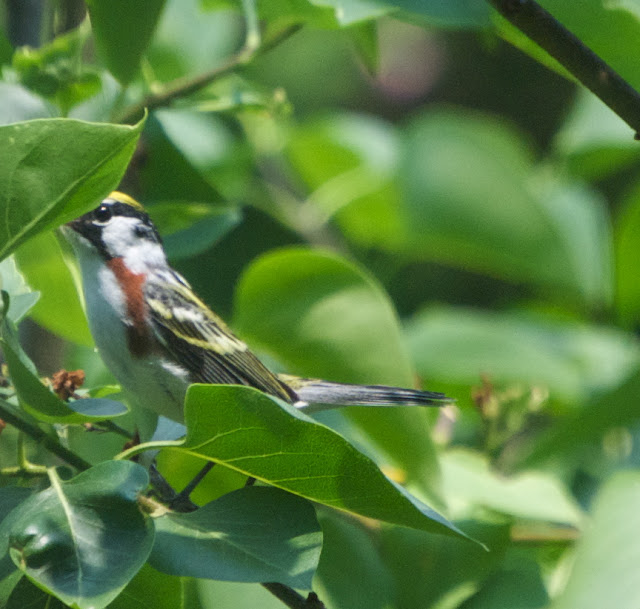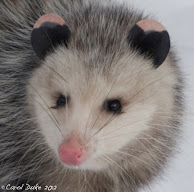Buds and birds will return soon and I will welcome both with a joyous heart! To continue the on going parade of Flower Hill Farm birds, I would like to introduce another striking warbler. Chestnut-sided Warblers (Dendroica pensylvanica) have been choosing this habitat for many years now.
Chestnut-sided Warblers can be sighted high up in the trees such as this Rock Maple, or in lower shrubs like the Blueberries below.
The songbirds particularly enjoy the Blueberry bushes and one day I happened upon a bit of a duel between two Chestnut-sided males. The only 'deadly weapons' they hold would be their sharp beaks, but truly they do not fight to the death.
These images of male pursuing male clearly shows why these birds have the given name of Chestnut-sided Warbler. A streak of chestnut or reddish-brown is like a brushstroke painted along their side.
Breeding males will not tolerate one another within a small territory. The bright yellow-green cap they wear is enhanced here by the sunlight.
Eventually they will settle down . . . and get on with the more important business of spring.
Singing their tiny hearts out to attract a mate is what both little warblers would rather be doing. One of their sweet songs is a series of high pitched notes that some hear as "pleased, pleased, pleased to MEETCHA." Many birds have more than one song and do improvise, as well as, have a variety of communicating calls. The Yellow Warbler I introduced earlier has a very similar voice to the Chestnut-sided Warbler. When I hear their melodious twitters in the gardens, it is most confusing trying to determine the warbler the song belongs to. Only by seeing, whilst I am hearing can I be certain.
The female Chestnut-sided Warbler does not have the solid chestnut streak but dons small patches of the hue. She also lacks the bolder black lines through her eyes and face. She, as with most females of the bird population, simply prefers a duller frock. Note the two yellowish wing bars.
Like other warblers the Chestnut-sided Warbler enjoys gleaning the leaves and blossoms of shrubs and trees for insects.
A female Chestnut-sided Warbler seems quite relaxed in this moment . . .
until . . . she notices my large black eye upon her. Then she stretches into a more concerned form.
For the end of the Chestnut-sided contingent, a male beautifully displays his vivid patterns and prowess for hunting arachnids. I so look forward to the return of green and these precious garden friends.
For now this is what our March looks like, though today is warmer with rain and melting snow!
Most winters bring about some tragedies in the gardens and landscape and this one is no different. It is particularly hard to see my beloved native Black Cherry ('Michael's Tree') lose half of its canopy. I wonder if the Baltimore Orioles will nest there again or might they feel the tree is greatly altered. They usually nest on the far side of the remaining canopy. Of course my greatest concern is for the long lasting health of this beautiful tree.
The Bird Parade marches on in my next several posts.











































































































































